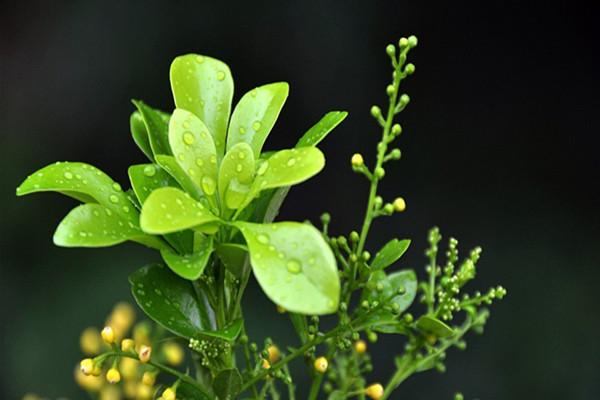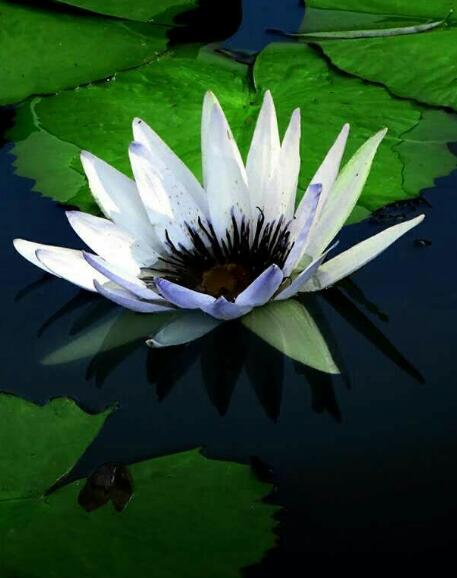How to prevent and cure rotten leaf disease of water lilies?
[symptoms] the standing leaves are commonly harmed. At the initial stage of the disease, chlorotic spots appear on the leaves of water lilies, and the surrounding tissues are necrotic, and then expand into irregular spots, light brown to dark brown. The floating leaves are dark to dark gray, with inconspicuous wheel markings and scattered black spots, causing the leaf edge to die. In the later stage of the disease, there are many small black grains scattered on the disease spot, that is, the conidium of the pathogen.
[pathogen and incidence regularity] the pathogen is Thermophilic Phytophthora, which belongs to the subphylum of semi-knowns and the genus Phytophthora. Conidia subglobose or oblate, brown. The pathogen overwintered on the diseased leaves by conidia. Conidia are transmitted by wind and rain, invading or directly invading from the wound. High temperature and humidity are beneficial to the disease of water lilies. The period from May to September is the onset period. After October, the pathogen overwintered by forming conidia on the diseased residual leaves, which became the first infection source in the following year. The disease of water lily was mild from pre-flowering to early flowering, and the disease developed rapidly from late flowering to fruiting stage. The disease of lotus planted in tank was more serious than that in pond, and the disease in small tank was more serious. The high temperature, high humidity and rainy season are beneficial to the spread of the disease. The occurrence and severity of water lily diseases are mainly related to air temperature and air relative humidity.
[control methods] New disease-resistant varieties of water lilies were planted in ①. When ② occurs sporadically, the diseased leaves can be removed in time to avoid spreading harm. ③ advocates composting by retting with enzyme bacteria. At the initial stage of ④, 36% methyl thiophanate suspension was sprayed, or 75% daconine wettable powder 1000 times plus 50% carbendazim wettable powder 1000 times, or 27% high fat membrane 200x solution plus 70% mancozeb wettable powder 800g 1000x solution, or 1lvl 100 equivalent Bordeaux solution, or 27% copper noble suspension 600x solution.
Symptoms and control of lotus leaf rot
Lotus [NelumbonuciferaGaertn. Nymphaeaceae]
[symptoms] most of the disease spots on the leaf surface are born between the radial veins, showing small chlorotic spots at first, then expanding into nearly round to amorphous spots, brown to purple-brown edges, gray-brown to gray-white in the middle, and scattered small particles with different densities on the spots. the disease spots can be connected to each other into patches, and the disease spots are easy to break and fall off into perforations, and even only the main veins remain, causing the lotus leaves to show a broken umbrella.
[pathogen and pathogenic characteristics] the pathogen is Pseudomonas aeruginosa [Phyllostictahydro-philaSpeg.]. The pathogen overwintered on the diseased remnant with mycelium and conidia, and the conidia spread to the new lotus leaves by wind and rain for infection, and the conidia produced in the diseased part were repeatedly infected. High temperature and humidity are beneficial to the disease, and the disease develops rapidly from flowering to seed-setting stage. Poor fertility or partial application of nitrogen fertilizer is more susceptible to disease. There were differences in resistance among varieties, such as Fanlou Spring in Wuhan, Hubei Province, and Yinhong Qianye and Xihu Honglian were more resistant.
[prevention and control methods]
① was used to remove the disease residue.
Disease resistant varieties were selected for ②.
③ should strengthen the management of fertilizer and water, increase the application of potassium fertilizer, and avoid partial nitrogen and high water temperature (> 35 ℃).
In the early stage of ④, it is appropriate to spray 0.5% Bordeaux solution alternately, or 30% copper oxychloride + 75% chlorothalonil (1 ∶ 1) 800 × 1000 times, or 80% Dasheng wettable powder 8000 times, or 40% flusilazole EC 8000 times, or 50% methoxysilane water agent 1500 times, or 50% Baogong wettable powder 1000 times, or 69% Amgram manganese zinc + 75% chlorothalonil wettable powder (1 ∶ 1) 1500 times Or 25% nitrilazole EC 8000 times, 3-4 times, spray once every 7-15 days depending on the weather.
Symptoms and control methods of lotus leaf rot
Lotus [NelumbonuciferaGaertn. Nymphaeaceae]
[symptoms] most of the disease spots on the leaf surface are born between the radial veins, showing small chlorotic spots at first, then expanding into nearly round to amorphous spots, brown to purple-brown edges, gray-brown to gray-white in the middle, and scattered small particles with different densities on the spots. the disease spots can be connected to each other into patches, and the disease spots are easy to break and fall off into perforations, and even only the main veins remain, causing the lotus leaves to show a broken umbrella.
[pathogen and pathogenic characteristics] the pathogen is Pseudomonas aeruginosa [Phyllostictahydro-philaSpeg.]. The pathogen overwintered on the diseased remnant with mycelium and conidia, and the conidia spread to the new lotus leaves by wind and rain for infection, and the conidia produced in the diseased part were repeatedly infected. High temperature and humidity are beneficial to the disease, and the disease develops rapidly from flowering to seed-setting stage. Poor fertility or partial application of nitrogen fertilizer is more susceptible to disease. There were differences in resistance among varieties, such as Fanlou Spring in Wuhan, Hubei Province, and Yinhong Qianye and Xihu Honglian were more resistant.
[prevention and control methods]
① was used to remove the disease residue.
Disease resistant varieties were selected for ②.
③ should strengthen the management of fertilizer and water, increase the application of potassium fertilizer, and avoid partial nitrogen and high water temperature (> 35 ℃).
In the early stage of ④, it is appropriate to spray 0.5% Bordeaux solution alternately, or 30% copper oxychloride + 75% chlorothalonil (1 ∶ 1) 800 × 1000 times, or 80% Dasheng wettable powder 8000 times, or 40% flusilazole EC 8000 times, or 50% methoxysilane water agent 1500 times, or 50% Baogong wettable powder 1000 times, or 69% Amgram manganese zinc + 75% chlorothalonil wettable powder (1 ∶ 1) 1500 times Or 25% nitrilazole EC 8000 times, 3-4 times, spray once every 7-15 days depending on the weather.
- Prev

How do Milan flowers reproduce?
How to reproduce Milan flower, the propagation of Milan flower mainly has cutting and high-altitude striping and other methods. The main results are as follows: 1. Cutting propagation is generally carried out from June to August. The cuttings should choose the Lignified branches of the year, which are 10 to 15 centimeters long, cut off the lower leaves, and leave only 2 or 3 leaves at the apex.
- Next

Why do water lilies not bloom?
Why do water lilies not bloom, whether potted or pond raised water lilies, do not love the phenomenon of flowering from time to time. Flower growers can quickly reverse the lilies 'reluctance to bloom only if they manage them according to specific conditions. in general
Related
- Fuxing push coffee new agricultural production and marketing class: lack of small-scale processing plants
- Jujube rice field leisure farm deep ploughing Yilan for five years to create a space for organic food and play
- Nongyu Farm-A trial of organic papaya for brave women with advanced technology
- Four points for attention in the prevention and control of diseases and insect pests of edible fungi
- How to add nutrient solution to Edible Fungi
- Is there any good way to control edible fungus mites?
- Open Inoculation Technology of Edible Fungi
- Is there any clever way to use fertilizer for edible fungus in winter?
- What agents are used to kill the pathogens of edible fungi in the mushroom shed?
- Rapid drying of Edible Fungi

